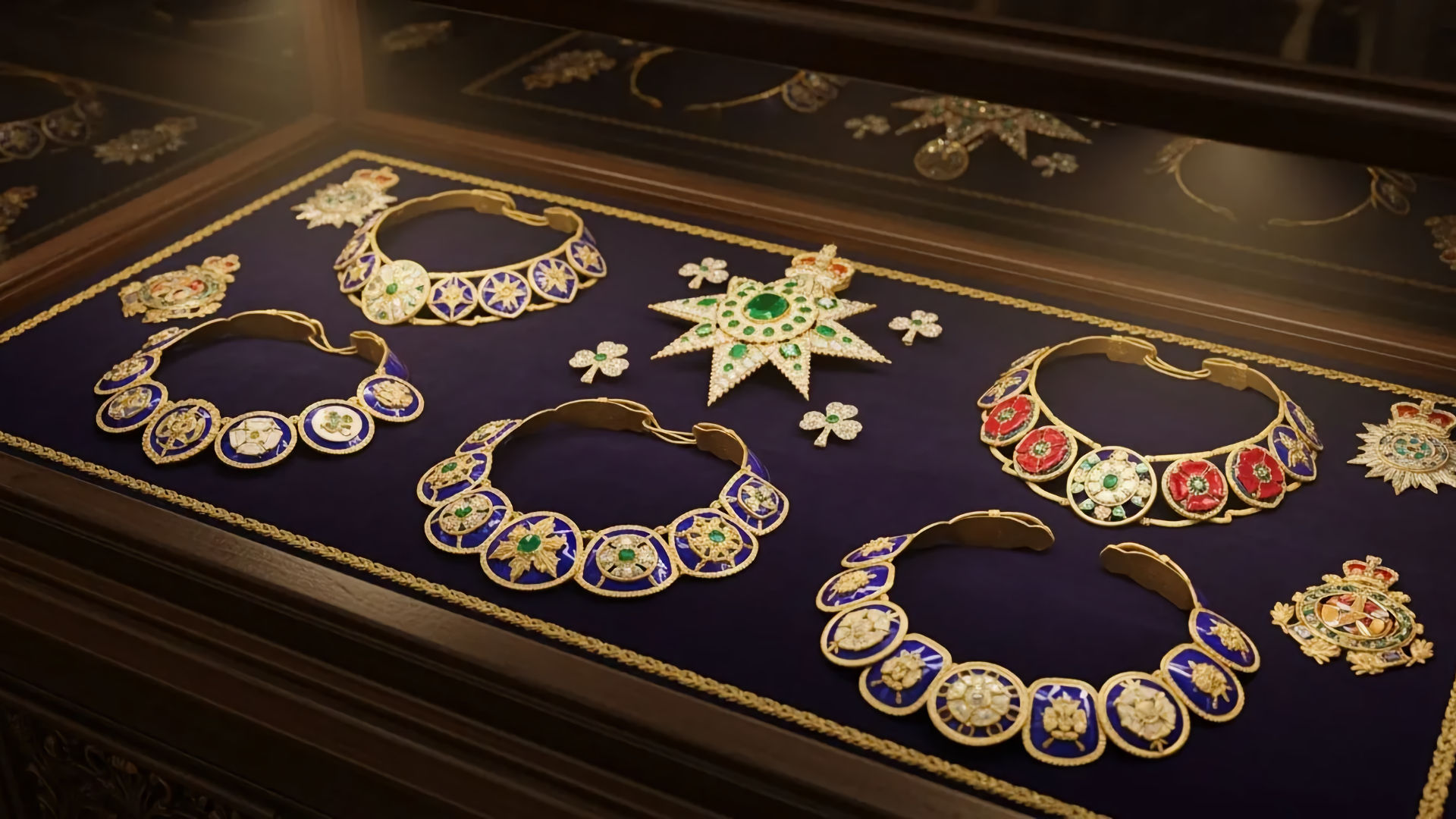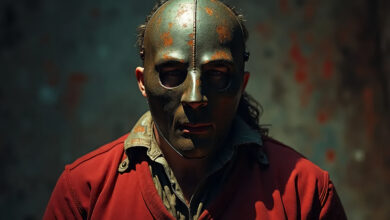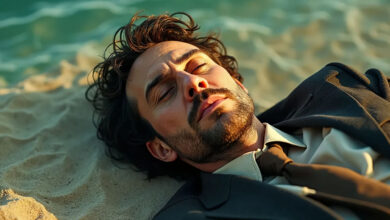The Theft of the Crown Jewels of Ireland
At the heart of this mystery lie several objects: a jewel-encrusted badge and star, ceremonial regalia known collectively as the Irish Crown Jewels, as well as the collars of five knights, all associated with the Order of St. Patrick, a chivalric order created in 1783 for the Anglo-Irish elite. The jewels were intended for use by the Grand Master of the Order, and representative of the British Crown, the Lord Lieutenant of Ireland.
Jewels Fit for a Kingdom
In March 1831, King William IV ordered new regalia to be made. These jewels incorporated hundreds of precious gemstones, taken partly from royal collections, and were crafted by the prestigious London firm Rundell & Bridge. They included emeralds, rubies and diamonds; dazzling, lavishly detailed symbols of British prestige in Ireland.
Despite being commonly referred to as the Irish Crown Jewels, the stolen items were not an actual crown but a collection of lavish ceremonial regalia. The centrepieces were the Grand Master’s star and badge of the Most Illustrious Order of St. Patrick, made in 1831 for King William IV. These items were encrusted with a jaw-dropping 394 precious stones, including emeralds, rubies, and sparkling white diamonds. The badge featured a cross of St. Patrick surrounded by shamrocks and surmounted by a harp and crown, symbolising the union between the monarchy and Ireland, though filtered through the lens of British colonial rule.
But it wasn’t just the main regalia that vanished. Along with the star and badge, five gold and enamel collars belonging to Knights of the Order of St. Patrick were also stolen. These ornate chains consisted of alternating rose, thistle, and shamrock motifs, representing England, Scotland, and Ireland, linked by intricate gold knots. Hanging from each collar was a badge of the Order, featuring St. Patrick trampling a serpent underfoot, set against a bright blue enamel background. These collars weren’t just decorative; they were heavy, meticulously crafted symbols of aristocratic authority and chivalric prestige.
From their inception, the jewels were intended for ceremonial use rather than political power. Yet in 1907, a dramatic heist changed their place in history: on 6 July, the regalia were discovered missing from their secure location in Dublin Castle.
Altogether, the stolen items were not just of extraordinary monetary value, but of immense political and symbolic importance. Their loss wasn’t just a matter of stolen jewellery; it was the disappearance of imperial regalia at the height of rising Irish nationalism, and an embarrassment to the British establishment that reverberated far beyond Dublin Castle.
That disappearance placed the jewels at the crossroads of legend, scandal, and suppression, and more than a century later, the case remains unresolved.
The Setting: Dublin Castle and Weak Security
The jewels were held in what should have been formidable security, the Office of Arms within Dublin Castle, under the supervision of Sir Arthur Vicars, the Ulster King of Arms. By 1903, plans had been made to move the regalia into a new strongroom. But the new safe was too big to fit through the doorway, so it was instead installed in the Ulster King of Arms’s library inside the Office of Arms.
The system of keys was weak. Seven latch‑keys were held by staff, and two keys for the safe were in Vicars’ personal custody. Security incidents had already occurred: doors to the office and strong rooms had been left open on separate occasions; intruders had been discovered; the safe’s placement outside the strongroom was itself a curious lapse.
On 6 July 1907, a cleaning woman discovered the office’s safe empty. The inner security doors were still bolted, but the safe’s interior was bare. Removed were the badge and star of the Order, as well as collars belonging to several knights of the Order. The theft was dramatic in timing: it was only days before King Edward VII was due to visit for the Irish International Exhibition, during which ceremonial functions involving the regalia were planned.
The disruption was acute: the investiture ceremony involving Lord Castletown was cancelled. The public and monarch alike were embarrassed, and from that moment onward, Dublin Castle’s prestige was severely shaken. The theft struck at symbolism: not the Crown jewels of a king, but the regalia of a British order in Ireland, in an era already fraught with nationalist tension.
The Investigation and Internal Scandal
The police work that followed was extensive yet flawed. The Dublin Metropolitan Police and the Royal Irish Constabulary led the immediate response; Scotland Yard sent Detective Chief Inspector John Kane to assist, and reports from Kane are believed to have named suspects, but his report was never released to the public.
Vicars was heavily scrutinised. He denied wrongdoing, but appeared negligent: he was later forced to resign for not exercising proper custody of the regalia. He publicly accused his second in command, Francis “Frank” Shackleton, of complicity. A Royal Commission in 1908 ultimately cleared Shackleton of charges, attributing the affair largely to Vicars’ failures.
Another suspect was Captain Richard William Howard Gorges, an Irishman implicated by parliamentary speeches in 1912. He was never prosecuted for the jewel theft, though his name remains controversially connected.
The theft generated a scandal that went beyond mere criminal suspicion. Rumours circulated of suppression, high society secrets, and that prominent figures might be implicated. The fact that the official report naming suspects was suppressed and withheld fueled public cynicism.
Arthur Conan Doyle, the Sherlock Holmes author and a relative of Vicars, offered his services. But his involvement yielded no breakthrough.
Later reports hinted that the jewels might have been hidden somewhere inside the castle itself, perhaps behind false walls or floorboards. During renovations in 1983, officials reportedly looked behind the walls of the Clock Tower part of Dublin Castle, but nothing was found.
In time, the Office of Arms was moved, and the Ulster King of Arms position became defunct. The trail, eventually, went cold.
Theories and Speculation
The theft spawned a wealth of theories, many wild, many plausible:
Inside Job
Given the security laxity and key distribution, the consensus among many historians is that this was an inside job. Someone with familiarity, access, or influence likely orchestrated the removal. The safe was not forced open; the jewels were extracted cleanly.
The involvement of Castle staff, Vicars himself, or high-ranking insiders has always been suspected.
Smuggling and Breakdown
Some theories suggest the jewels were smuggled out of Ireland, perhaps to the Netherlands or continental Europe. Once there, they may have been dismantled, gemstones separated and sold individually, making tracing nearly impossible.
Another option is that they were hidden intact within Ireland itself, in a secret cache, submerged, or built into structures. Some believe part of them might still await rediscovery.
Political Motive or Nationalist Theft
Because the jewels were symbols of British power, some proposed that Irish nationalist groups orchestrated the theft to embarrass the British administration in Ireland. Though no overt evidence supports this, the timing, just days before a royal visit, makes the idea tempting.
Other speculation links the theft to a cover-up for a sexual scandal. Vicars was known to be drunk and negligent; rumours of homosexual activity among Anglo-Irish elites were whispered at the time, and some believe the investigation may have been suppressed to avoid scandal.
Partial Return or Sale to the Crown
Some suggest that fragments of the jewels may have quietly returned to royal or government hands, reabsorbed into other state collections. Others believe the jewels were sold back through discreet channels to avoid public scandal. Yet no documented trace of them in royal or state inventories has ever surfaced.
The “Still Inside the Castle” Hypothesis
Because the theft seemed surgical, and parts of Dublin Castle had never been fully renovated at the time, some maintain the jewels may be hidden in plain sight, in false compartments, behind walls, or under floorboards. The 1983 search during the removal of part of the castle turned up nothing, but many parts of the structure have been altered since. This hypothesis keeps the possibility alive for future discovery.
Legacy and Cultural Impact
The theft of the Irish Crown Jewels is known as one of Ireland’s greatest unsolved heists. Because it combined political symbolism, aristocratic scandal, and inside intrigue, it has become part of Irish cultural folklore. Books, documentaries, and new research revisit the case periodically. Some of the more recent articles frame it as a clash of power, secrecy, and institutional failure.
In art and popular memory, objects representing the vanished jewels sometimes surface in antique fairs, auctions, and legends, fueling treasure hunts and speculation. Perhaps more significantly, the case underscores how political and social power can distort justice. Suppression of reports, possible protection of elites, and institutional disinterest all hint that secrecy played as significant a role as theft.
Echoes of a Vanished Treasure
Over a century later, the Irish Crown Jewels remain lost in history’s cracks. Whether hidden, destroyed, smuggled, or broken apart, the regalia’s disappearance is a reminder of how symbols can die more mysteriously than people.
The case also reminds us of how privilege and secrecy often protect the powerful. Even when a crime is brazen, involving royal regalia in the seat of colonial power, it is possible for the perpetrators to vanish into shadows and for official memory to be restrained.
The Lost Crown Jewels of Ireland are more than missing jewellery: they are a vanished symbol, a scandal, and an open wound in the story of colonial Ireland. Someday, someone might uncover the box or trace a long-buried gem to its original cut. Until then, the regalia remain a phantom, dazzling in memory, hiding in silence, a mystery still unsolved.
The Theft of the Crown Jewels of Ireland FAQ
The Crown Jewels of Ireland were ceremonial regalia of the Order of St. Patrick, including a jewelled badge and star, adorned with emeralds and diamonds.
They vanished from a safe in the Bedford Tower of Dublin Castle sometime in early July 1907, just before a royal visit.
No one was ever formally charged. The case remains unsolved, though suspicions focused on a senior official who had private access.
The jewels have never been recovered. Their fate remains unknown, fuelling speculation they were smuggled abroad or quietly destroyed.






